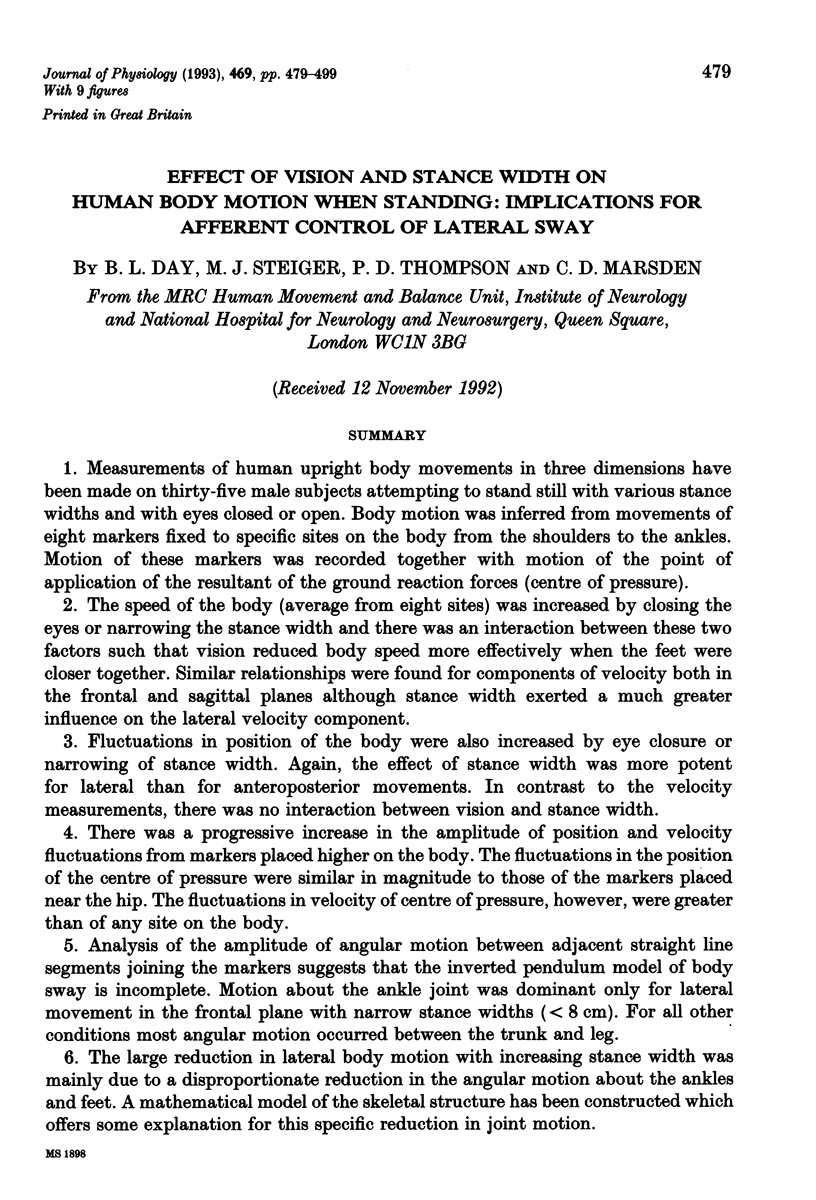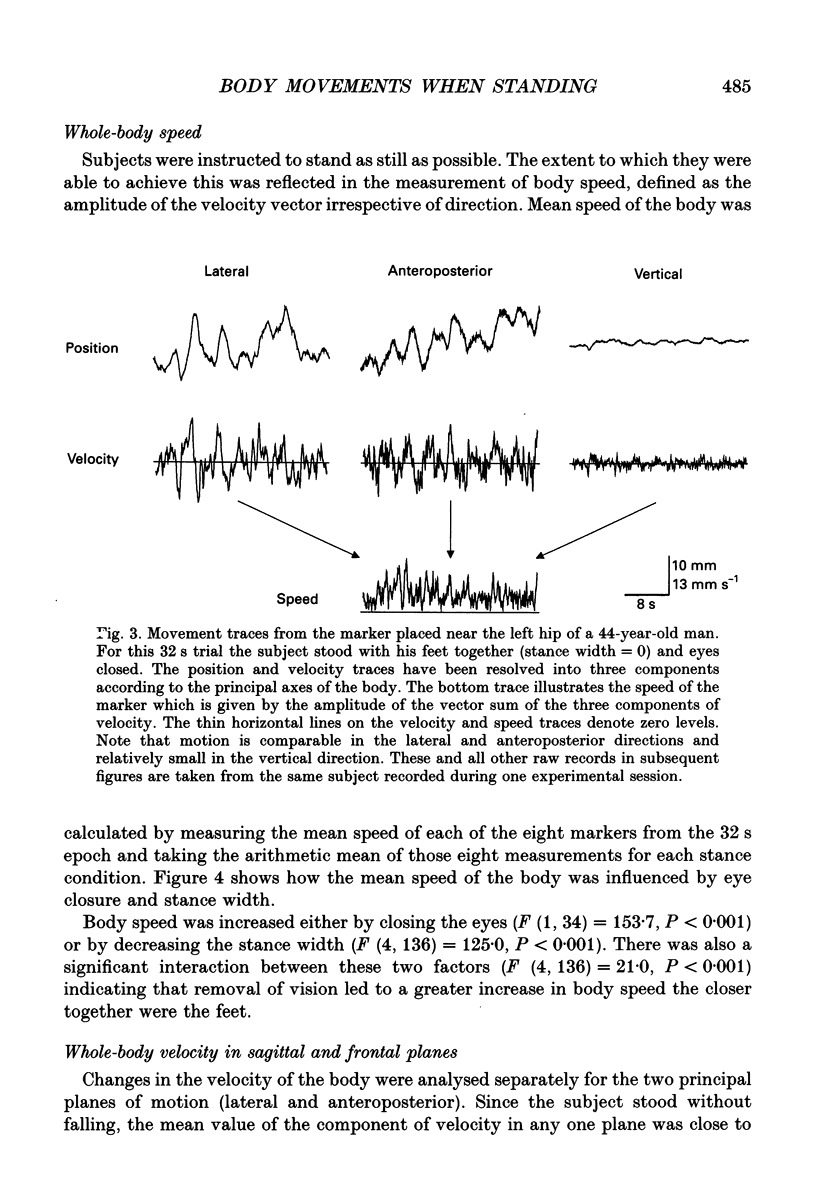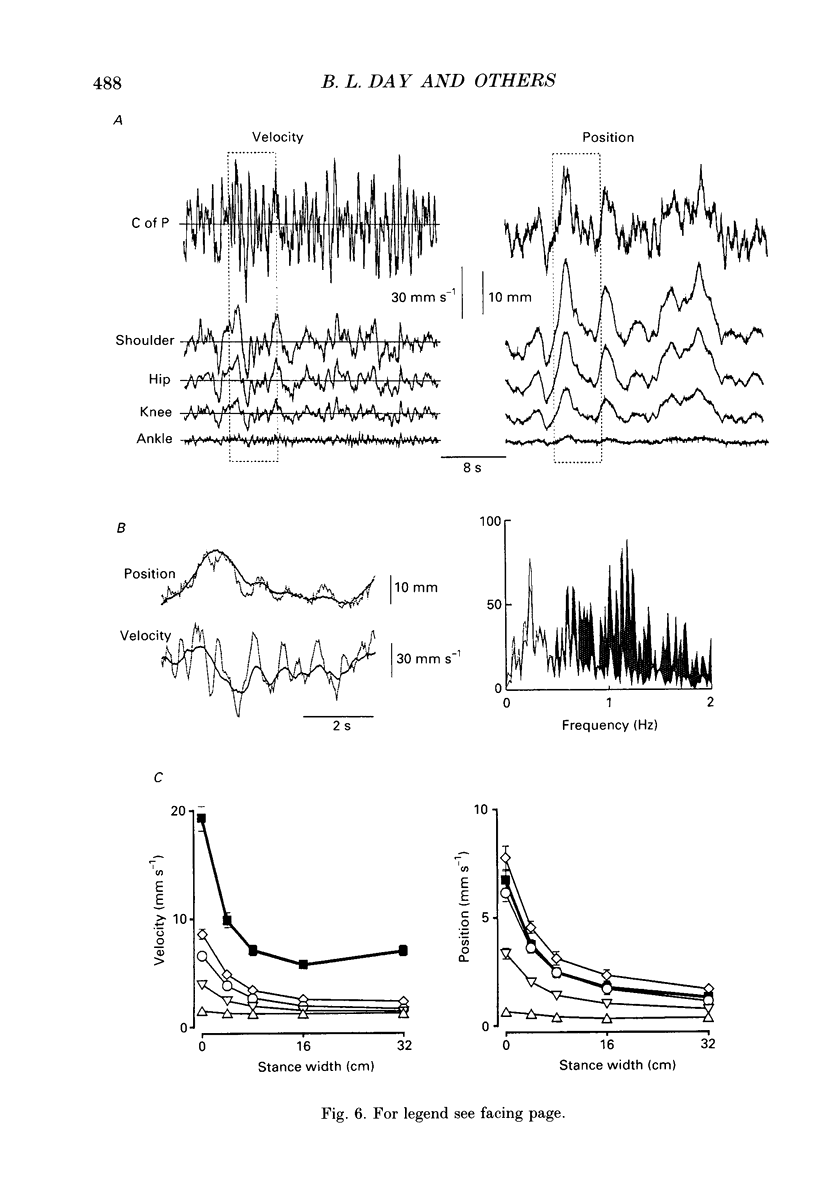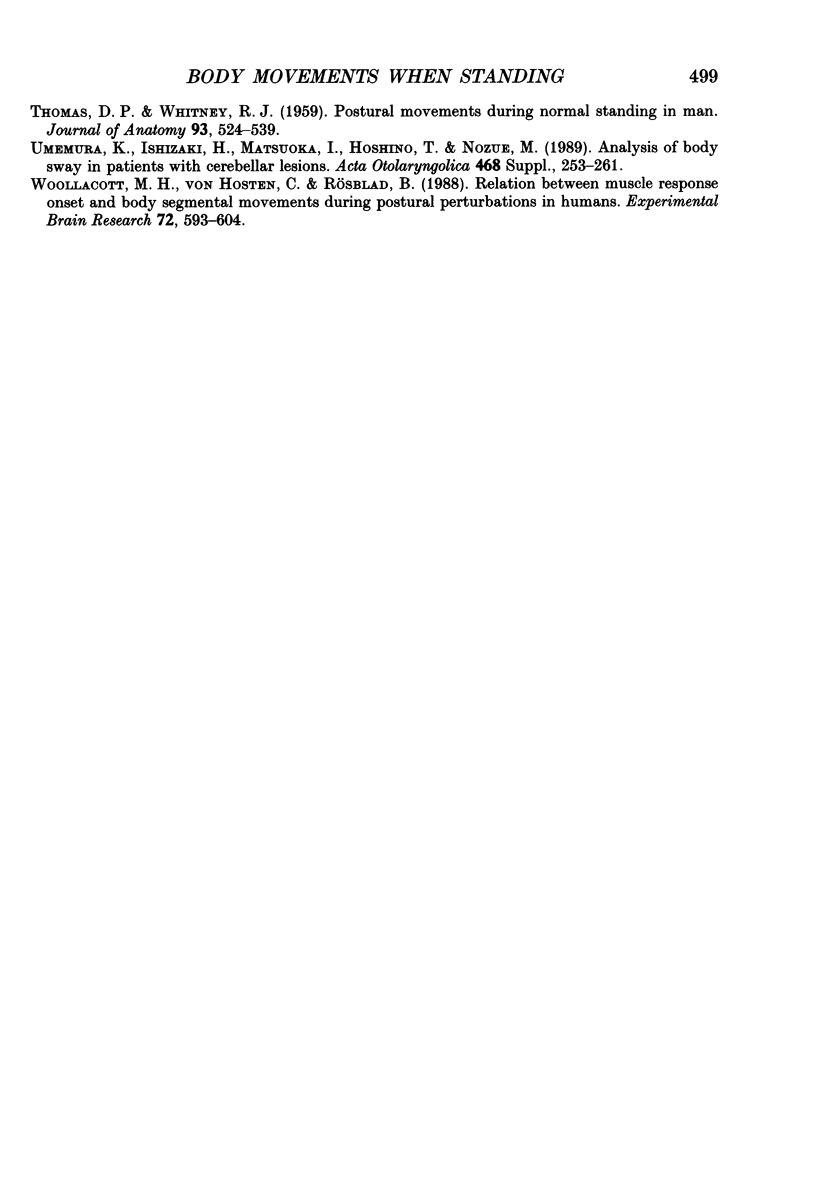Abstract
1. Measurements of human upright body movements in three dimensions have been made on thirty-five male subjects attempting to stand still with various stance widths and with eyes closed or open. Body motion was inferred from movements of eight markers fixed to specific sites on the body from the shoulders to the ankles. Motion of these markers was recorded together with motion of the point of application of the resultant of the ground reaction forces (centre of pressure). 2. The speed of the body (average from eight sites) was increased by closing the eyes or narrowing the stance width and there was an interaction between these two factors such that vision reduced body speed more effectively when the feet were closer together. Similar relationships were found for components of velocity both in the frontal and sagittal planes although stance width exerted a much greater influence on the lateral velocity component. 3. Fluctuations in position of the body were also increased by eye closure or narrowing of stance width. Again, the effect of stance width was more potent for lateral than for anteroposterior movements. In contrast to the velocity measurements, there was no interaction between vision and stance width. 4. There was a progressive increase in the amplitude of position and velocity fluctuations from markers placed higher on the body. The fluctuations in the position of the centre of pressure were similar in magnitude to those of the markers placed near the hip. The fluctuations in velocity of centre of pressure, however, were greater than of any site on the body. 5. Analysis of the amplitude of angular motion between adjacent straight line segments joining the markers suggests that the inverted pendulum model of body sway is incomplete. Motion about the ankle joint was dominant only for lateral movement in the frontal plane with narrow stance widths (< 8 cm). For all other conditions most angular motion occurred between the trunk and leg. 6. The large reduction in lateral body motion with increasing stance width was mainly due to a disproportionate reduction in the angular motion about the ankles and feet. A mathematical model of the skeletal structure has been constructed which offers some explanation for this specific reduction in joint motion.(ABSTRACT TRUNCATED AT 400 WORDS)
Full text
PDF




















Images in this article
Selected References
These references are in PubMed. This may not be the complete list of references from this article.
- Amblard B., Crémieux J., Marchand A. R., Carblanc A. Lateral orientation and stabilization of human stance: static versus dynamic visual cues. Exp Brain Res. 1985;61(1):21–37. doi: 10.1007/BF00235617. [DOI] [PubMed] [Google Scholar]
- Diener H. C., Dichgans J., Bacher M., Gompf B. Quantification of postural sway in normals and patients with cerebellar diseases. Electroencephalogr Clin Neurophysiol. 1984 Feb;57(2):134–142. doi: 10.1016/0013-4694(84)90172-x. [DOI] [PubMed] [Google Scholar]
- Dieterich M., Brandt T. Wallenberg's syndrome: lateropulsion, cyclorotation, and subjective visual vertical in thirty-six patients. Ann Neurol. 1992 Apr;31(4):399–408. doi: 10.1002/ana.410310409. [DOI] [PubMed] [Google Scholar]
- Fitzpatrick R. C., Taylor J. L., McCloskey D. I. Ankle stiffness of standing humans in response to imperceptible perturbation: reflex and task-dependent components. J Physiol. 1992 Aug;454:533–547. doi: 10.1113/jphysiol.1992.sp019278. [DOI] [PMC free article] [PubMed] [Google Scholar]
- Kirby R. L., Price N. A., MacLeod D. A. The influence of foot position on standing balance. J Biomech. 1987;20(4):423–427. doi: 10.1016/0021-9290(87)90049-2. [DOI] [PubMed] [Google Scholar]
- Labadie E. L., Awerbuch G. I., Hamilton R. H., Rapesak S. Z. Falling and postural deficits due to acute unilateral basal ganglia lesions. Arch Neurol. 1989 May;46(5):492–496. doi: 10.1001/archneur.1989.00520410026017. [DOI] [PubMed] [Google Scholar]
- Masdeu J. C., Gorelick P. B. Thalamic astasia: inability to stand after unilateral thalamic lesions. Ann Neurol. 1988 Jun;23(6):596–603. doi: 10.1002/ana.410230612. [DOI] [PubMed] [Google Scholar]
- Mauritz K. H., Dichgans J., Hufschmidt A. Quantitative analysis of stance in late cortical cerebellar atrophy of the anterior lobe and other forms of cerebellar ataxia. Brain. 1979 Sep;102(3):461–482. doi: 10.1093/brain/102.3.461. [DOI] [PubMed] [Google Scholar]
- Nashner L. M. Adapting reflexes controlling the human posture. Exp Brain Res. 1976 Aug 27;26(1):59–72. doi: 10.1007/BF00235249. [DOI] [PubMed] [Google Scholar]
- Okubo J., Watanabe I., Takeya T., Baron J. B. Influence of foot position and visual field condition in the examination for equilibrium function and sway of the center of gravity in normal persons. Agressologie. 1979;20(2):127–132. [PubMed] [Google Scholar]
- Overstall P. W., Exton-Smith A. N., Imms F. J., Johnson A. L. Falls in the elderly related to postural imbalance. Br Med J. 1977 Jan 29;1(6056):261–264. doi: 10.1136/bmj.1.6056.261. [DOI] [PMC free article] [PubMed] [Google Scholar]
- Paulus W. M., Straube A., Brandt T. Visual stabilization of posture. Physiological stimulus characteristics and clinical aspects. Brain. 1984 Dec;107(Pt 4):1143–1163. doi: 10.1093/brain/107.4.1143. [DOI] [PubMed] [Google Scholar]
- SMITH J. W. The forces operating at the human ankle joint during standing. J Anat. 1957 Oct;91(4):545–564. [PMC free article] [PubMed] [Google Scholar]
- THOMAS D. P., WHITNEY R. J. Postural movements during normal standing in man. J Anat. 1959 Oct;93:524–539. [PMC free article] [PubMed] [Google Scholar]
- Umemura K., Ishizaki H., Matsuoka I., Hoshino T., Nozue M. Analysis of body sway in patients with cerebellar lesions. Acta Otolaryngol Suppl. 1989;468:253–261. doi: 10.3109/00016488909139057. [DOI] [PubMed] [Google Scholar]
- Woollacott M. H., von Hosten C., Rösblad B. Relation between muscle response onset and body segmental movements during postural perturbations in humans. Exp Brain Res. 1988;72(3):593–604. doi: 10.1007/BF00250604. [DOI] [PubMed] [Google Scholar]




